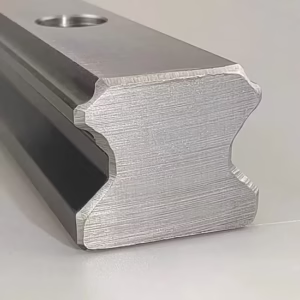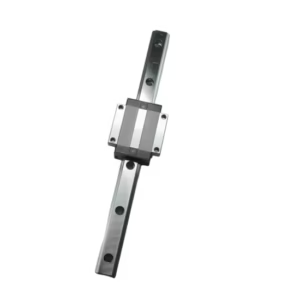Outline for Long-form Article on Linear Bearing Rail
| Section | Subtopics |
|---|---|
| Introduction | What is a linear bearing rail? Why it matters |
| Linear Bearing Rail | Definition, role, and key functions |
| Evolution of Linear Bearing Rail Systems | From bushings to advanced rail technology |
| Key Components | Rail, bearing block, rolling elements, seals |
| How Linear Bearing Rails Work | Recirculating elements, load distribution |
| Types of Linear Bearing Rails | Profile rails, round rails, miniature rails |
| Advantages of Linear Bearing Rails | Precision, rigidity, efficiency |
| Challenges and Limitations | Cost, contamination, alignment |
| Applications in CNC Machinery | Milling, grinding, 3D printing |
| Applications in Robotics | Automation, cobots, pick-and-place |
| Applications in Medical Technology | Imaging, surgery, diagnostics |
| Applications in Aerospace and Defense | Assembly, testing, satellite systems |
| Applications in Logistics and Packaging | Conveyors, warehouses, packaging lines |
| Linear Bearing Rails vs Other Motion Systems | Belts, bushings, wheels |
| Choosing the Right Linear Bearing Rail | Load, environment, accuracy, speed |
| Installation Best Practices | Mounting, alignment, torque |
| Maintenance and Care | Lubrication, inspection, cleaning |
| Common Problems and Failures | Misalignment, wear, contamination |
| Future of Linear Bearing Rails | Smart rails, predictive maintenance |
| Sustainability in Linear Motion Systems | Eco-friendly designs, energy efficiency |
| Top Global Manufacturers | THK, HIWIN, Bosch Rexroth |
| Linear Bearing Rails in DIY and Maker Projects | 3D printers, CNC routers |
| Cost Considerations | Factors influencing price |
| Buying Guide | Where and how to buy |
| Linear Bearing Rail | Recap and importance |
| FAQs | Six practical Q&As |
| Conclusion | Final thoughts and outlook |
Introduction
Every modern machine that requires precision, stability, and smooth linear motion depends on a strong backbone: the linear bearing rail. Whether it’s a CNC machine cutting through titanium, a robotic arm assembling electronics, or a medical imaging system scanning patients, linear bearing rails ensure accuracy and repeatability.
They are more than just guiding systems; they represent the perfect balance of load-bearing strength and friction reduction. Without them, automation and advanced manufacturing would struggle to meet today’s exacting standards.
Linear Bearing Rail
A linear bearing rail is a mechanical system designed to support and guide objects in straight-line motion. It consists of a hardened steel rail paired with a bearing block or carriage that moves along it. Inside the block are rolling elements—typically steel balls or rollers—that minimize friction and provide smooth, precise movement.
These systems are essential in industries where reliability and precision are critical, from small 3D printers to aerospace assembly lines.
Evolution of Linear Bearing Rail Systems
The earliest linear motion relied on sliding bushings. While simple, they generated high friction and wore out quickly. As demand for precision grew, industries transitioned to recirculating ball linear bearings.
Modern linear bearing rails now include:
Profile rails for high rigidity
Round rails for easy installation
Miniature rails for compact devices
Smart rails with integrated sensors
Key Components
Rail – Precision-ground hardened steel track.
Bearing Block/Carriage – The moving part containing rolling elements.
Rolling Elements – Steel balls or rollers that circulate to reduce friction.
Seals and Shields – Protect against dust and debris.
Lubrication System – Provides long-term smooth operation.
How Linear Bearing Rails Work
The principle is simple: rolling elements recirculate inside the block as it moves along the rail. This allows heavy loads to be carried with minimal resistance. The load distribution across multiple contact points ensures rigidity and stability, even at high speeds.
Types of Linear Bearing Rails
Profile Rails
Square, rigid, highly accurate
Used in CNC machining, robotics
Round Rails
Cylindrical, easier to install
Common in logistics and packaging
Miniature Rails
Compact, lightweight
Found in medical and electronics industries
Advantages of Linear Bearing Rails
High precision and repeatability
Long service life
Handles heavy loads with stability
Low friction and reduced noise
Compact and efficient design
Increased speed and productivity
Challenges and Limitations
Higher upfront cost than bushings
Sensitive to dirt and contamination
Require precise installation
Depend on lubrication for smooth operation
Applications in CNC Machinery
CNC machines rely on linear bearing rails for:
Milling and turning
Grinding systems
Laser and water jet cutters
3D printers
They ensure cutting tools move with micron-level precision.
Applications in Robotics
Linear bearing rails are essential in:
Industrial robotic arms
Pick-and-place machines
Collaborative robots (cobots)
They allow robots to perform high-speed, accurate, and repeatable movements.
Applications in Medical Technology
MRI and CT scanners
Robotic surgical systems
Automated laboratory equipment
Miniature linear rails ensure smooth, vibration-free performance in sensitive devices.
Applications in Aerospace and Defense
Aircraft assembly lines
Satellite positioning systems
Flight simulators
These require rigid, vibration-resistant motion systems.
Applications in Logistics and Packaging
Conveyor systems
Automated warehouses
High-speed packaging lines
Smooth rail systems increase efficiency and reliability.
Linear Bearing Rails vs Other Motion Systems
| Feature | Linear Bearing Rail | Belts & Pulleys | Bushings |
|---|---|---|---|
| Precision | Very High | Medium | Low |
| Load Capacity | High | Medium | Low |
| Friction | Very Low | Medium | High |
| Durability | Long | Medium | Short |
| Cost | Higher | Lower | Lowest |
Choosing the Right Linear Bearing Rail
Load requirements
Precision needs
Environmental factors (dust, temperature, moisture)
Budget
Installation Best Practices
Ensure rails are aligned
Use flat, rigid mounting surfaces
Apply correct torque settings
Test for smooth travel before operation
Maintenance and Care
Lubricate periodically
Clean rails regularly
Replace worn seals
Inspect for misalignment
Common Problems and Failures
Misalignment causing uneven wear
Lack of lubrication increasing friction
Contaminants damaging rolling elements
Overloading rails beyond design limits
Future of Linear Bearing Rails
Smart rails with IoT sensors
Self-lubricating materials
AI-based predictive maintenance
Lightweight composites for efficiency
Sustainability in Linear Motion Systems
Use of recyclable materials
Energy-efficient manufacturing
Longer lifespan reducing waste
Top Global Manufacturers
THK – Japan
HIWIN – Taiwan
Bosch Rexroth – Germany
NSK Motion Solutions – Japan
SKF – Sweden
Linear Bearing Rails in DIY and Maker Projects
CNC routers
3D printers
Laser cutters
Affordable linear rail kits allow hobbyists to build professional-quality machines.
Cost Considerations
Price depends on:
Rail type (profile vs round)
Bearing design (ball vs roller)
Precision grade
Brand reputation
Buying Guide
Best sources include:
Manufacturer websites
Industrial suppliers like RS Components and McMaster-Carr
Online engineering marketplaces
Linear Bearing Rail
In summary, the linear bearing rail is the heart of modern precision motion. From CNC machines to robotics and aerospace, it provides the stability and accuracy industries demand.
FAQs
What is a linear bearing rail used for?
It enables precise straight-line motion in machines and automation systems.
Which is better: profile or round rails?
Profile rails are more rigid and precise, while round rails are easier to install.
Do linear bearing rails need lubrication?
Yes, lubrication prevents wear and extends lifespan.
Can linear bearing rails handle heavy loads?
Yes, especially roller-type rails designed for high loads.
Are linear bearing rails expensive?
They cost more than bushings but are more durable and efficient.
Can they be used outdoors?
Yes, but they need protective seals and corrosion-resistant coatings.
Conclusion
The linear bearing rail may seem like a small component, but its impact is enormous. It enables industries to achieve speed, precision, and reliability. From medical robotics to aerospace engineering, its role is unmatched.
With advances in smart sensors and eco-friendly designs, the future of linear bearing rails promises even greater efficiency and sustainability.




